History of feminism
| Part of a series on |
| Feminism |
|---|
 |
|
|
The history of feminism comprises the narratives (
Modern Western feminist history is conventionally split into time periods, or "waves", each with slightly different aims based on prior progress:[7][8]
- First-wave feminism of the 19th and early 20th centuries focused on overturning legal inequalities, particularly addressing issues of women's suffrage
- Second-wave feminism (1960s–1980s) broadened debate to include cultural inequalities, gender norms, and the role of women in society
- Third-wave feminism (1990s–2000s) refers to diverse strains of feminist activity, seen by third-wavers themselves both as a continuation of the second wave and as a response to its perceived failures[9]
- trans-inclusivity, and an open discourse about rape culturein the social media era
Although the "waves" construct has been commonly used to describe the history of feminism, the concept has also been criticized by non-White feminists for ignoring and erasing the history between the "waves", by choosing to focus solely on a few famous figures, on the perspective of a white bourgeois woman and on popular events, and for being racist and colonialist.[10][11][12][13][14]
Early feminism

People and activists who discuss or advance women's equality prior to the existence of the feminist movement are sometimes labeled as protofeminist.[6] Some scholars criticize this term because they believe it diminishes the importance of earlier contributions or that feminism does not have a single begin or linear history as implied by terms such as protofeminist or postfeminist.[4][15][16][17]
Around 24 centuries ago,[18] Plato, according to Elaine Hoffman Baruch, "[argued] for the total political and sexual equality of women, advocating that they be members of his highest class, ... those who rule and fight".[19]
Andal, a female Tamil saint, lived around the 7th or 8th century.[20][21] She is well known for writing Tiruppavai.[21] Andal has inspired women's groups such as Goda Mandali.[22] Her divine marriage to Vishnu is viewed by some as a feminist act, as it allowed her to avoid the regular duties of being a wife and gain autonomy.[23] In the 12th century, the Waldensians Christian sect espoused some feministic ideas.[24]
Renaissance Feminism
Italian-French writer
Renaissance defenses of women are present in a variety of literary genre and across Europe with a central claim of equality. Feminists appealed to principles that progressively lead to discourse of economic property injustice themes. Feminizing society was a way for women at this time to use literature to create interdependent and non-hierarchical systems that provided opportunities for both women and men.[33]
Men have also played an important role in the history of defending that women are capable and able to compete equally with men, including Antonio Cornazzano, Vespasiano de Bisticci, and Giovanni Sabadino degli Arienti. Castiglione continues this trend of defending woman's moral character and that traditions are at fault for the appearance of women's inferiority. However, the critique is that there is no advocacy for social change, leaving her out of the political sphere, and abandoning her to traditional domestic roles. Although, many of them would encourage that if women were to be included in the political sphere it would be a natural consequence of their education. In addition, some of these men state that men are at fault for the lack of knowledge of intellectual women by leaving them out of historical records.[34]
One of the most important 17th-century feminist writers in the English language was Margaret Cavendish, Duchess of Newcastle-upon-Tyne.[35][36] Her knowledge was recognized by some, such as proto-feminist Bathsua Makin, who wrote that "The present Dutchess of New-Castle, by her own Genius, rather than any timely Instruction, over-tops many grave Grown-Men," and considered her a prime example of what women could become through education.[37]
17th century
In 1622, Marie de Gournay published The Equality of Men and Women, in which she argued for equality of the sexes.[40]
18th century: the Age of Enlightenment
The Age of Enlightenment was characterized by secular intellectual reasoning and a flowering of philosophical writing. Many Enlightenment philosophers defended the rights of women, including Jeremy Bentham (1781), Marquis de Condorcet (1790), and Mary Wollstonecraft (1792).[41] Other important writers of the time that expressed feminist views included Abigail Adams, Catharine Macaulay,[42] and Hedvig Charlotta Nordenflycht.
Jeremy Bentham
The English
In his Introduction to the Principles of Morals and Legislation (1781), Bentham strongly condemned many countries' common practice to deny women's rights due to allegedly inferior minds.[47] Bentham gave many examples of able female regents.
Marquis de Condorcet
Olympe de Gouges and a Declaration
Following de Condorcet's repeated, yet failed, appeals to the National Assembly in 1789 and 1790, Olympe de Gouges (in association with the Society of the Friends of Truth) authored and published the Declaration of the Rights of Woman and of the Female Citizen in 1791. This was another plea for the French Revolutionary government to recognize the natural and political rights of women.[51] De Gouges wrote the Declaration in the prose of the Declaration of the Rights of Man and of the Citizen, almost mimicking the failure of men to include more than a half of the French population in egalité. Even though the Declaration did not immediately accomplish its goals, it did set a precedent for a manner in which feminists could satirize their governments for their failures in equality, seen in documents such as A Vindication of the Rights of Woman and A Declaration of Sentiments.[52]
Wollstonecraft and A Vindication
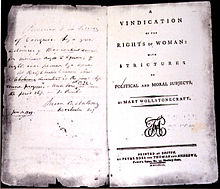
Perhaps the most cited feminist writer of the time was Mary Wollstonecraft, She identified the education and upbringing of women as creating their limited expectations based on a self-image dictated by the typically male perspective.[53] Despite her perceived inconsistencies (Miriam Brody referred to the "Two Wollstonecrafts")[54] reflective of problems that had no easy answers, this book remains a foundation stone of feminist thought.[1]
Wollstonecraft believed that both genders contributed to inequality. She took women's considerable power over men for granted, and determined that both would require education to ensure the necessary changes in social attitudes. Given her humble origins and scant education, her personal achievements speak to her own determination. For many commentators, Wollstonecraft represents the first codification of
19th century

The feminine ideal
19th-century feminists reacted to cultural inequities including the pernicious, widespread acceptance of the
Feminism in fiction
As
Male authors also recognized injustices against women. The novels of George Meredith, George Gissing,[68] and Thomas Hardy,[69] and the plays of Henrik Ibsen[70] outlined the contemporary plight of women. Meredith's Diana of the Crossways (1885) is an account of Caroline Norton's life.[71] One critic later called Ibsen's plays "feministic propaganda".[16]
John Neal
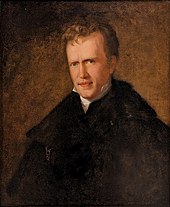
John Neal is remembered as America's first women's rights lecturer.[72] Starting in 1823[73] and continuing at least as late as 1869,[74] he used magazine articles, short stories, novels, public speaking, political organizing, and personal relationships to advance feminist issues in the United States and Great Britain, reaching the height of his influence in this field circa 1843.[75] He declared intellectual equality between men and women, fought coverture, and demanded suffrage, equal pay, and better education and working conditions for women. Neal's early feminist essays in the 1820s fill an intellectual gap between Mary Wollstonecraft, Catharine Macaulay, and Judith Sargent Murray and Seneca Falls Convention-era successors like Sarah Moore Grimké, Elizabeth Cady Stanton, and Margaret Fuller.[76] As a male writer insulated from many common forms of attack against female feminist thinkers, Neal's advocacy was crucial in bringing the field back into the mainstream in England and the US.[77]
In his essays for
Marion Reid and Caroline Norton
At the outset of the 19th century, the dissenting feminist voices had little to no social influence.[citation needed] There was little sign of change in the political or social order, nor any evidence of a recognizable women's movement. Collective concerns began to coalesce by the end of the century, paralleling the emergence of a stiffer social model and code of conduct that Marion Reid described as confining and repressive for women.[1] While the increased emphasis on feminine virtue partly stirred the call for a woman's movement, the tensions that this role caused for women plagued many early-19th-century feminists with doubt and worry, and fueled opposing views.[84]
In Scotland, Reid published her influential A Plea for Woman in 1843,[85] which proposed a transatlantic Western agenda for women's rights, including voting rights for women.[86]
Caroline Norton advocated for changes in British law. She discovered a lack of legal rights for women upon entering an abusive marriage.[87] The publicity generated from her appeal to Queen Victoria[88] and related activism helped change English laws to recognize and accommodate married women and child custody issues.[87]
Florence Nightingale and Frances Power Cobbe
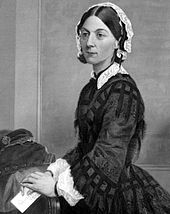
While many women including Norton were wary of organized movements,[89] their actions and words often motivated and inspired such movements.[citation needed] Among these was Florence Nightingale, whose conviction that women had all the potential of men but none of the opportunities[90] impelled her storied nursing career.[91] At the time, her feminine virtues were emphasized over her ingenuity, an example of the bias against acknowledging female accomplishment in the mid-1800s.[91]
Due to varying ideologies, feminists were not always supportive of each other's efforts. Harriet Martineau and others dismissed Wollstonecraft's[92] contributions as dangerous, and deplored Norton's[92] candidness, but seized on the abolitionist campaign that Martineau had witnessed in the United States[93] as one that should logically be applied to women. Her Society in America[94] was pivotal: it caught the imagination of women who urged her to take up their cause.[citation needed]

Feminists of previous centuries charged women's exclusion from education as the central cause for their domestic relegation and denial of social advancement, and women's 19th-century education was no better.[citation needed] Frances Power Cobbe, among others, called for education reform, an issue that gained attention alongside marital and property rights, and domestic violence.
Female journalists like Martineau and Cobbe in Britain, and Margaret Fuller in America, were achieving journalistic employment, which placed them in a position to influence other women. Cobbe would refer to "Woman's Rights" not just in the abstract, but as an identifiable cause.[97]
Ladies of Langham Place
Smith and Parkes, together and apart, wrote many articles on education and employment opportunities. In the same year as Norton, Smith summarized the legal framework for injustice in her 1854 A Brief Summary of the Laws of England concerning Women.
Harriet Taylor published her Enfranchisement in 1851, and wrote about the inequities of family law. In 1853, she married John Stuart Mill, and provided him with much of the subject material for The Subjection of Women.
Emily Davies also encountered the Langham group, and with Elizabeth Garrett created SPEW branches outside London.
Educational reform
The interrelated barriers to education and employment formed the backbone of 19th-century feminist reform efforts, for instance, as described by Harriet Martineau in her 1859 Edinburgh Journal article, "Female Industry".[clarification needed] These barriers did not change in conjunction with the economy. Martineau, however, remained a moderate, for practical reasons, and unlike Cobbe, did not support the emerging call for the vote.[citation needed]
The education reform efforts of women like Davies and the Langham group slowly made inroads.
In the 1883
As part of the continuing dialogue between British and American feminists,
Women's campaigns
Campaigns gave women opportunities to test their new political skills and to conjoin disparate social reform groups. Their successes include the campaign for the
Generally, women were outraged by the inherent inequity and misogyny of the legislation.[citation needed] For the first time, women in large numbers took up the rights of prostitutes. Prominent critics included Blackwell, Nightingale, Martineau, and Elizabeth Wolstenholme. Elizabeth Garrett, unlike her sister, Millicent, did not support the campaign, though she later admitted that the campaign had done well.[citation needed]
Josephine Butler, already experienced in prostitution issues, a charismatic leader, and a seasoned campaigner, emerged as the natural leader[102] of what became the Ladies National Association for the Repeal of the Contagious Diseases Acts in 1869.[103][104] Her work demonstrated the potential power of an organized lobby group. The association successfully argued that the Acts not only demeaned prostitutes, but all women and men by promoting a blatant sexual double standard. Butler's activities resulted in the radicalization of many moderate women. The Acts were repealed in 1886.[citation needed]
On a smaller scale,
19th to 21st centuries
The examples and perspective in this section deal primarily with Western culture and do not represent a worldwide view of the subject. (January 2023) |
Feminists did not recognize separate waves of feminism until the second wave was so named by journalist Martha Weinman Lear in a 1968 New York Times Magazine article "The Second Feminist Wave", according to Alice Echols.[106] Jennifer Baumgardner reports criticism by professor Roxanne Dunbar-Ortiz of the division into waves[107] and the difficulty of categorizing some feminists into specific waves,[108] argues that the main critics of a wave are likely to be members of the prior wave who remain vital,[108] and that waves are coming faster.[108] The "waves debate" has influenced how historians and other scholars have established the chronologies of women's political activism.[2]
First wave
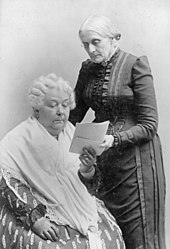
The 19th- and early 20th-century feminist activity in the English-speaking world that sought to win women's suffrage, female education rights, better working conditions, and abolition of gender double standards is known as first-wave feminism. The term "first-wave" was coined retrospectively when the term second-wave feminism was used to describe a newer feminist movement that fought social and cultural inequalities beyond basic political inequalities.[109] In the United States, feminist movement leaders campaigned for the national
Activism for the equality of women was not limited to the United States. In mid-nineteenth century Persia,

In the United States, the antislavery campaign of the 1830s served as both a cause ideologically compatible with feminism and a blueprint for later feminist political organizing. Attempts to exclude women only strengthened their convictions.[

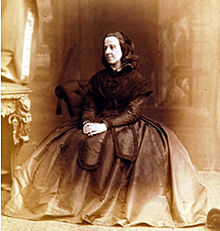
Stanton and
Stanton once observed regarding assumptions of female inferiority, "The worst feature of these assumptions is that women themselves believe them".[122] However this attempt to replace androcentric (male-centered) theological[clarification needed] tradition with a gynocentric (female-centered) view made little headway in a women's movement dominated by religious elements; thus she and Gage were largely ignored by subsequent generations.[123][124]
By 1913, Feminism (originally capitalized) was a household term in the United States.
Suffrage



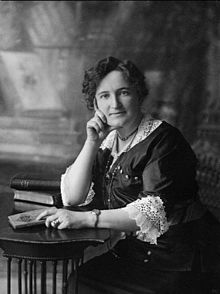
The women's right to vote, with its legislative representation, represented a paradigm shift where women would no longer be treated as second-class citizens without a voice. The women's suffrage campaign is the most deeply embedded campaign of the past 250 years.[127][dubious ]
At first, suffrage was treated as a lower priority. The French Revolution accelerated this,[
German women were involved in the Vormärz, a prelude to the 1848 revolution. In Italy, Clara Maffei, Cristina Trivulzio Belgiojoso, and Ester Martini Currica were politically active[clarification needed] in the events leading up to 1848. In Britain, interest in suffrage emerged from the writings of Wheeler and Thompson in the 1820s, and from Reid, Taylor, and Anne Knight in the 1840s.[citation needed] While New Zealand was the first sovereign state where women won the right to vote (1893), they did not win the right to stand in elections until later. The Australian State of South Australia was the first sovereign state in the world to officially grant full suffrage to women (in 1894).
The suffragettes
The Langham Place ladies set up a suffrage committee at an 1866 meeting at Elizabeth Garrett's home, renamed the London Society for Women's Suffrage in 1867.[128] Soon similar committees had spread across the country, raising petitions, and working closely with John Stuart Mill. When denied outlets by establishment periodicals, feminists started their own, such as Lydia Becker's Women's Suffrage Journal in 1870.
Other publications included
Despite this, the women accrued political experience, which translated into slow progress at the local government level. But after years of frustration, many women became increasingly radicalized. Some refused to pay taxes, and the Pankhurst family emerged as the dominant movement influence, having also founded the Women's Franchise League in 1889, which sought local election suffrage for women.[129]
International suffrage
The Isle of Man, a UK dependency, was the first free standing jurisdiction to grant women the vote (1881), followed by the right to vote (but not to stand) in New Zealand in 1893, where Kate Sheppard[130] had pioneered reform. Some Australian states had also granted women the vote. This included Victoria for a brief period (1863–5), South Australia (1894), and Western Australia (1899). Australian women received the vote at the Federal level in 1902, Finland in 1906, and Norway initially in 1907 (completed in 1913).[131]
Early 20th century
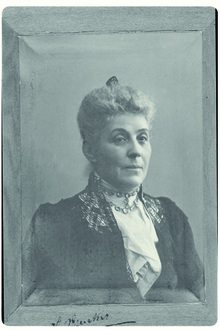
In the early part of the 20th century, also known as the Edwardian era, there was a change in the way women dressed from the Victorian rigidity and complacency. Women, especially women who married a wealthy man, would often wear what we consider today, practical.[132]
Books, articles, speeches, pictures, and papers from the period show a diverse range of themes other than political reform and suffrage discussed publicly.[citation needed] In the Netherlands, for instance, the main feminist issues were educational rights, rights to medical care,[133] improved working conditions, peace, and dismantled gender double standards.[134][135][136][137][138][139] Feminists identified as such with little fanfare.[citation needed]
) around her. Veterans such as Elizabeth Garrett also joined.In 1906, the
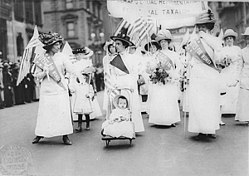
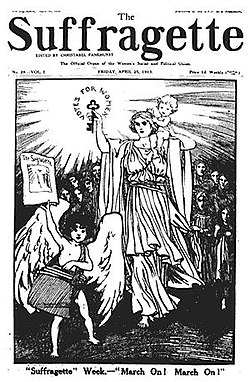
The protests slowly became more violent, and included heckling, banging on doors, smashing shop windows, and arson.

Feminist science fiction
At the beginning of the 20th century,
During the 1920s, writers such as
Feminist science fiction poses questions about social issues such as how society constructs gender roles, how reproduction defines gender, and how the political power of men and women are unequal.[144][145] Some of the most notable feminist science fiction works have illustrated these themes using utopias to explore societies where gender differences or gender power imbalances do not exist, and dystopias to explore worlds where gender inequalities are escalated, asserting a need for feminist work to continue.[146]
During the first and second world wars
Women entered the labor market during the
Feminist scholars like Françoise Thébaud and Nancy F. Cott note a conservative reaction to World War I in some countries, citing a reinforcement of traditional imagery and literature that promotes motherhood. The appearance of these traits in wartime has been called the "nationalization of women."[147]
In the years between the wars, feminists fought discrimination and establishment opposition to advances in women's roles in the social world and workforce.[148][149] In Virginia Woolf's A Room of One's Own, Woolf describes the extent of the backlash and her frustration. By now, the word "feminism" was in use, but with a negative connotation from mass media, which discouraged women from self-identifying as such.[citation needed] When Rebecca West, another prominent writer, had been attacked as "a feminist", Woolf defended her. West has been remembered for her comment "I myself have never been able to find out precisely what feminism is: I only know that people call me a feminist whenever I express sentiments that differentiate me from a doormat, or a prostitute."[150]
In the 1920s, the nontraditional styles and attitudes of
Electoral reform
The United Kingdom's
The granting of the vote did not automatically give women the right to stand for Parliament and the Parliament (Qualification of Women) Act was rushed through just before the following election. Seventeen women were among the 1700 candidates nominated. Christabel Pankhurst narrowly failed to win a seat, and Constance Markievicz (Sinn Féin) was the first woman elected in Ireland in 1918, but as an Irish nationalist, refused to take her seat.[153]
In 1919 and 1920, both
European women received the vote in Finland (that time still an autonomous state under Czar Russia) in 1906, in Denmark and Iceland in 1915 (full in 1919), the Russian Republic in 1917, Austria, Germany and Canada in 1918, many countries including the Netherlands in 1919, Czechoslovakia (today Czech Republic and Slovakia) in 1920, and Turkey and South Africa in 1930. French women did not receive the vote until 1945. Liechtenstein was one of the last countries, in 1984.[155]
After French women were given the right to vote in 1945, two women's organizations were founded in the French colony of Martinique. Le Rassemblement féminin and l'Union des femmes de la Martinique both had the goal of encouraging women to vote in the upcoming elections. While l'Union des femmes de la Martinique, founded by Jeanne Lero was influenced by beliefs, Le Rassemblement féminin, founded by Paulette Nardal, claimed to not support any particular political party and only encouraged women to take political action in order to create social change.[156]
Social reform
The political change did not immediately change social circumstances. With the economic recession, women were the most vulnerable sector of the workforce. Some women who held jobs prior to the war were obliged to forfeit them to returning soldiers, and others were excessed. With limited franchise, the UK
Reproductive rights

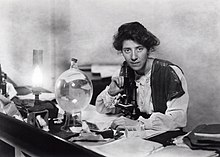
British laws prevented feminists from discussing and addressing reproductive rights.
In America,
In the Netherlands,
1940s
In most front line countries, women volunteered or were conscripted for various duties in support of the national war effort. In Britain, women were drafted and assigned to industrial jobs or to non-combat military service. The British services enrolled 460,000 women. The largest service, Auxiliary Territorial Service, had a maximum of 213,000 women enrolled, many of whom served in anti-aircraft gun combat roles.[172][173] In many countries, including Germany and the Soviet Union, women volunteered or were conscripted. In Germany, women volunteered in the League of German Girls and assisted the Luftwaffe as anti-aircraft gunners, or as guerrilla fighters in Werwolf units behind Allied lines.[174] In the Soviet Union, about 820,000 women served in the military as medics, radio operators, truck drivers, snipers, combat pilots, and junior commanding officers.[175]
Many American women retained their domestic chores and often added a paid job, especially one related to a war industry. Much more so than in the previous war, large numbers of women were hired for unskilled or semi-skilled jobs in munitions, and barriers against married women taking jobs were eased. The popular Rosie the Riveter icon became a symbol for a generation of American working women.[citation needed] In addition, some 300,000 women served in U.S. military uniform with organizations such as Women's Army Corps and WAVES. With many young men gone, sports organizers tried to set up professional women's teams, such as the All-American Girls Professional Baseball League, which closed after the war. After the war, most munitions plants closed, and civilian plants replaced their temporary female workers with returning veterans, who had priority.[176]
Second wave


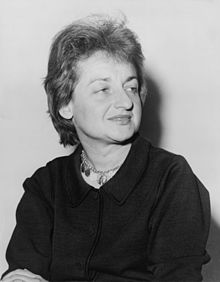

"Second-wave feminism" identifies a period of
Betty Friedan, The Feminine Mystique, and Women's Liberation
A landmark feminist work appeared in 1949 called The Second Sex, a book written by Simone de Beauvoir. The critical text pertained to every facet of what would later be defined as gender discourse. Beauvoir goes into detail on the treatment of women throughout entire history of the world and analyses the modes of oppression enforced by patriarchy and then critiques it.[178] In 1963, Betty Friedan's exposé The Feminine Mystique became the voice for the discontent and disorientation women felt in being shunted into homemaking positions after their college graduations. In the book, Friedan explored the roots of the change in women's roles from essential workforce during World War II to homebound housewife and mother after the war, and assessed the forces that drove this change in perception of women's roles.[citation needed]
The expression "Women's Liberation" has been used to refer to feminism throughout history.
This time was marked by increased female enrolment in higher education, the establishment of academic women's studies courses and departments,[190] and feminist ideology in other related fields, such as politics, sociology, history, and literature.[15] This academic shift in interests questioned the status quo, and its standards and authority.[191]
The rise of the Women's Liberation movement revealed "multiple feminisms", or different underlying feminist lenses, due to the diverse origins from which groups had coalesced and intersected, and the complexity and contentiousness of the issues involved.
Feminist writing
The publication of Betty Friedan's The Feminine Mystique has been credited with beginning the so-called "second wave" of feminist activism, during which time feminist writers furthered conversations about women's political and sexual concerns.[196] Examples include Gloria Steinem's Ms. magazine and Kate Millett's Sexual Politics. Millett's bleak survey of male writers, their attitudes and biases, to demonstrate that sex is politics, and politics is power imbalance in relationships. Shulamith Firestone's The Dialectic of Sex described a feminist revolution based in Marxism, referenced as the "sex war."[197] Considering the debates over patriarchy, she claimed that male domination dated to "back beyond recorded history to the animal kingdom itself."[197]
US women's writing included works such as Susan Brownmiller's 1975 Against Our Will, which introduced an explicit agenda against male violence, specifically male sexual violence, in a treatise on rape. Her work has been referred to as "groundbreaking" due to its framing of rape as a social problem; it also had a fair number of critics, primarily from feminists of color, who took issue with Brownmiller's approach to race.[200] Brownmiller's other major book, In Our Time (2000), is a history of women's liberation.
In Academic circles, feminist theology was a growing interest. Phyllis Trible wrote extensively throughout the 1970s to critique biblical interpretation of the time, using a type of critique known as Rhetorical criticism.[201] Trible's analysis of biblical text seeks to explain that the bible itself is not sexist, but that it is centuries of sexism in societies that have produced this narrative.[202]
Feminist views on pornography
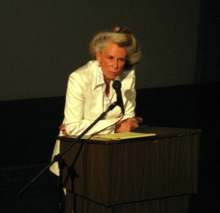
This approach has evolved to transform the research and perspective on rape from an individual experience into a social problem.[209]
Third wave
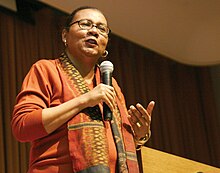
Third-wave feminism began in the early 1990s in response to what young women perceived as failures of the second-wave. It also responds to the backlash against the second-wave's initiatives and movements.[citation needed] Third-wave feminism seeks to challenge or avoid second-wave "essentialist" definitions of femininity, which over-emphasized the experiences of white, upper-middle-class women. A post-structuralist interpretation of gender and sexuality, or an understanding of gender as outside binary maleness and femaleness, is central to much of the third wave's ideology.[citation needed] Third-wave feminists often describe "micropolitics",[clarification needed] and challenge second-wave paradigms about whether actions are unilaterally good for females.[177][210][211][212][clarification needed]
These aspects of third-wave feminism arose in the mid-1980s. Feminist leaders rooted in the second wave like
Sexual politics
A few years later,
In reproductive rights, feminists sought the right to contraceptives (i.e., birth control), some of which were widely restricted in the US until the late 1960s and through the 1970s; the birth control pill, for example, was primarily available only to married women until the mid 1970s, though other women did find ways to get the pill anyhow.[215] Access to abortion was also widely demanded so as to increase women's economic independence and bodily autonomy, but was more difficult to secure due to existing, deep societal divisions over the issue.
Shulamith Firestone, active during the second wave of feminism, argued reproductive technology is connected to reproductive rights.[216] Firestone believed in the enhancement of technologically concerning reproduction, in order to eliminate the obligation for women to reproduce and end oppression and inequality against them. Enhancing technology to empower women and abolish the gender hierarchy are the main focuses of a newer developing philosophy in feminism, known as cyberfeminism. Cyberfeminism has strong ties to reproductive rights and technology.
Third-wave feminists also fought to hasten social acceptance of female sexual freedom. As societal norms allowed men to have multiple sexual partners without rebuke, feminists sought sexual equality for that freedom and encouraged "
Global feminism
UN conferences on women
In 1946, the United Nations established a
Bridging East and West
"The definitional moment of third-wave feminism has been theorized as proceeding from critiques of the white women's movement that were initiated by women of color, as well as from the many instances of coalition work undertaken by U.S. third world feminists"[225] Third world feminists since the 1980s have been critics of class-bias, racism, and Eurocentrism among women and feminists, and theories of multiplicity and difference given by these feminists such as Sandoval, Minh-ha, and Mohanty have enabled young feminists to dismantle the idea of monolithic feminism. They have empowered them to recognize the differences and declare multiple identities of being female, despite constantly feeling caught between modernity and tradition. Even though Asian women found it difficult to relate completely with the western women's white problems, they related much with the women of color, and thus remolded it and built a bridge between both halves of feminism, the eastern and western, via interconnectedness among women around the world. They adapted and borrowed the 'western' ideas of feminism and women in the west incorporated the effects of women's movements in other parts of the world, while reinventing itself. Asian feminists acknowledged the need of recognizing multiple sources of domination in women's lives all across the world, refused to universalize women's experience as one, and instead recognized the differences among them due to different social locations. They claimed that although academic feminism introduced them to the idea of feminism, it failed to bring them closer to the sisters and mothers in their lives, and rather took them further away. Some have also argued that many goals of western feminism are not enough to assess women's progress in Asia because they are not necessarily relevant or exportable across the boundaries. Thus, they redefined it as one that drew upon their heritage, history, and experiences. As Grewal puts it, "These transnational feminist scholars enable us to rethink the way we construct and write the history of feminists in national and transnational contexts. Seeking to articulate transnational connections among women, they have suggested ways to move beyond constructed oppositions without ignoring the histories that informed these conflicts or the valid concerns about power relations that have represented or structured the conflicts up to this point."[226]
Fourth wave
Fourth-wave feminism is a recent development within the feminist movement. Jennifer Baumgardner identifies fourth-wave feminism as starting in 2008 and continuing into the present day.[227] Kira Cochrane, author of All the Rebel Women: The Rise of the Fourth Wave of Feminism,[228] defines fourth-wave feminism as a movement that is connected through technology.[229][230] Researcher Diana Diamond defines fourth-wave feminism as a movement that "combines politics, psychology, and spirituality in an overarching vision of change."[231]
Arguments for a new wave
In 2005, Pythia Peay first argued for the existence of a fourth wave of feminism, combining justice with
According to Kira Cochrane, a fourth wave had appeared in the U.K. and several other nations by 2012–13. It focused on: sexual inequality as manifested in "street harassment, sexual harassment, workplace discrimination[,] ... body-shaming";[234] media images, "online misogyny",[234] "assault[s] on public transport";[234] on intersectionality; on social media technology for communication and online petitioning for organizing; and on the perception, inherited from prior waves, that individual experiences are shared and thus can have political solutions.[234] Cochrane identified as fourth wave such organizations and websites as the Everyday Sexism Project and UK Feminista; and events such as Reclaim the Night, One Billion Rising, and "a Lose the Lads' mags protest",[234] where "many of [the leaders] ... are in their teens and 20s".[234]
In 2014, Betty Dodson, who is also acknowledged as one of the leaders of the early 1980s pro-sex feminist movement, expressed that she considers herself a fourth wave feminist. Dodson expressed that the previous waves of feminist were banal and anti-sexual, which is why she has chosen to look at a new stance of feminism, fourth wave feminism. In 2014, Dodson worked with women to discover their sexual desires through masturbation. Dodson says her work has gained a fresh lease of life with a new audience of young, successful women who have never had an orgasm. This includes fourth-wave feminists - those rejecting the anti-pleasure stance they believe third-wave feminists stand for.[235]
In 2014, Rhiannon Lucy Cosslett and Holly Baxter released their book, The Vagenda. The authors of the book both consider themselves fourth wave feminists. Like their website "The Vagenda", their book aims to flag and debunk the stereotypes of femininity promoted by the mainstream women's press.[236] One reviewer of the book has expressed disappointment with The Vagenda, saying that instead of being the "call to arms for young women" that it purports to be, it reads like a joyless dissertation detailing "everything bad the media has ever done to women."[237]
The Everyday Sexism Project
The Everyday Sexism Project began as a social media campaign on 16 April 2012 by Laura Bates, a British feminist writer. The aim of the site was to document everyday examples of sexism as reported by contributors around the world.[238] Bates established the Everyday Sexism Project as an open forum where women could post their experiences of harassment. Bates explains the Everyday Sexism Project's goal, ""The project was never about solving sexism. It was about getting people to take the first step of just realising there is a problem that needs to be fixed."[239]
The website was such a success that Bates decided to write and publish a book, Everyday Sexism, which further emphasizes the importance of having this type of online forum for women. The book provides unique insight into the vibrant movement of the upcoming fourth wave and the untold stories that women shared through the Everyday Sexism Project.[240]
Click! The Ongoing Feminist Revolution
In November 2015, a group of historians working with Clio Visualizing History [3] launched Click! The Ongoing Feminist Revolution.[4] This digital history exhibit examines the history of American feminism from the era of World War Two to the present. The exhibit has three major sections: Politics and Social Movements; Body and Health; and Workplace and Family. There are also interactive timelines linking to a vast array of sources documenting the history of American feminism and providing information about current feminist activism.
Criticisms of the wave metaphor
In the 1960s, feminists described their movements as the "second wave" of feminism. As the second wave emerges, the importance of this new wave was to revisit that the current women's right had a venerable past. This wave focused on the idea that these movements were a long tradition of activism and during the second wave, feminists began to rewrite U.S. history through recognizing that the suffrage movement was part of the nineteenth century movement around women's issues.[241] Presently, many contributions about the Second Wave Feminism was correlated with "hegemonic feminism". This feminism views sexism as the main oppression and it was mainly led by white individuals who "marginalized the activism and world views of women of color".[242] Women of color and white antiracist women clarify the rise of multiracial feminism through telling the history of the Second Wave feminism. One of the earlier feminist organizations of the Second Wave was a Chicana group named Hijas de Cuauntemoc (1971) which was named after an underground newspaper written by women during the 1910 Mexican Revolution.[242] Multiple other feminist organizations that were created in the early 1970s with Black, Asian, Latina, and Native American women have created a nationalist tradition of sending out a message that there is a need for people of color-led, independent organizations.[242]
During the 1990s, the United States feminist activity that was present in the 1960s through the 1980s was no longer expressed.[241] The wave metaphor for the Second Wave showed the 1960s movement as anything other than a historical situation, and showed that the nineteenth century movement was a bigger deal and had more impact on history than what was taught.[241] As many pondered on what state was feminism presently in, one idea emerged in the early 1990s as the "third wave". As emerging from the Second Wave and onto the Third Wave, the wave metaphor has reached its usefulness. Individuals are more aware of the significance the nineteenth century had on women's movement and are more aware of the emergence the 1960s had from their long struggle regarding women's issues.
National histories of feminism
France
The 18th century French Revolution's focus on égalité (equality) extended to the inequities faced by French women. The writer Olympe de Gouges amended the 1791 Declaration of the Rights of Man and of the Citizen into the Declaration of the Rights of Woman and of the Female Citizen, where she argued that women accountable to the law must also bear equal responsibility under the law. She also addressed marriage as a social contract between equals and attacked women's reliance on beauty and charm as a form of slavery.[243] Two years later, she was executed by guillotine.
The 19th century, conservative, post-Revolution France was inhospitable for feminist ideas, as expressed in the counter-revolutionary writings on the role of women by
While the word féminisme previously existed to describe the qualities of women, the word féministe was coined in 1872 by Alexandre Dumas fils to refer to liberated women.[246]
The Groupe Français d'Etudes Féministes were women intellectuals at the beginning of the 20th century who translated part of Bachofen's canon into French[247] and campaigned for the family law reform. In 1905, they founded L'entente, which published articles on women's history, and became the focus for the intellectual avant-garde. It advocated for women's entry into higher education and the male-dominated professions.[248] Meanwhile, the Parti Socialiste Féminin socialist feminists, adopted a Marxist version of matriarchy.[clarification needed] Like the Groupe Français, they toiled for a new age of equality, not for a return to prehistoric models of matriarchy.[249][250][clarification needed] French feminism of the late 20th century is mainly associated with psychoanalytic feminist theory, particularly the work of Luce Irigaray, Julia Kristeva, and Hélène Cixous.[251]
Germany
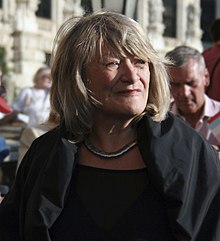
Modern feminism in
Iran
The Iranian women's rights movement first emerged some time after the
In 1992,
]Egypt
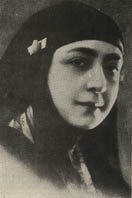
In 1899,
India
A new generation of Indian feminists emerged following global feminism. Indian women have greater independence from increased access to higher education and control over their reproductive rights.[260] Medha Patkar, Madhu Kishwar, and Brinda Karat are feminist social workers and politicians who advocate for women's rights in post-independence India.[260] Writers such as Amrita Pritam, Sarojini Sahoo, and Kusum Ansal advocate for feminist ideas in Indian languages.[261] Rajeshwari Sunder Rajan, Leela Kasturi, and Vidyut Bhagat are Indian feminist essayists and critics writing in English.[clarification needed]
China
Second- and third-wave feminism in China was characterized by a re-examination of women's roles during the reform movements of the early 20th century and the ways in which feminism was adopted by those various movements in order to achieve their goals. Later and current feminists have questioned whether gender equality has actually been fully achieved, and discuss current gender problems, such as the large
Japan
Japanese feminism as an organized political movement dates back to the early years of the 20th century when
Norway

Norwegian feminism's political origins are in the women's suffrage movement. Camilla Collett (1813–1895) is widely considered the first Norwegian feminist. Originating from a literary family, she wrote a novel and several articles on the difficulties facing women of her time, and, in particular, forced marriages. Amalie Skram (1846–1905), a naturalist writer, also served as the women's voice.[268]
The Norwegian Association for Women's Rights was founded in 1884 by Gina Krog and Hagbart Berner. The organization raised issues related to women's rights to education and economic self-determination, and, above all, universal suffrage. The Norwegian Parliament passed the women's right to vote into law on June 11, 1913. Norway was the second country in Europe (after Finland) to have full suffrage for women.[268]
Poland
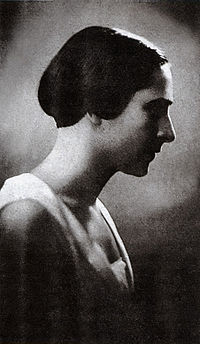
The development of feminism in Poland (
After the Second World War, the Polish
Histories of selected feminist issues
The examples and perspective in this section deal primarily with Western culture and do not represent a worldwide view of the subject. (January 2023) |
This section needs expansion. You can help by adding to it. (January 2023) |
Feminist theory

The sexuality and gender historian Nancy Cott distinguishes between modern feminism and its antecedents, particularly the struggle for suffrage.[
In the immediate postwar period,
The resurgence of feminist activism in the late 1960s was accompanied by an emerging literature of what might be considered female-associated issues, such as concerns for the earth, spirituality, and environmental activism.
Ann Taylor Allen[4] describes the differences between the collective male pessimism of male intellectuals such as Ferdinand Tönnies, Max Weber, and Georg Simmel at the beginning of the 20th century,[273] compared to the optimism of their female counterparts, whose contributions have largely been ignored by social historians of the era.[274]
See also
- Coverture
- History of brassieres
- Lesbian erasure
- List of suffragists and suffragettes
- List of women's rights activists
- List of women's organizations
- Mujeres Libres
- New Woman
- Timeline of second-wave feminism
- Timeline of women's suffrage
- Timeline of women's rights (other than voting)
- Victorian dress reform
- Women's music
- Women's suffrage organizations
- Women's rights in 2014
- 1975 Icelandic women's strike
References
- ^ ISBN 978-0-19-157803-8. Retrieved May 1, 2013.
- ISBN 978-0-394-53438-1. Retrieved May 1, 2013.
- ^ Witt, Charlotte (2012). "Feminist History of Philosophy". In Zalta, Edward N (ed.). The Stanford Encyclopedia of Philosophy (Fall 2012 ed.). Retrieved May 1, 2013.
- ^ PMID 19291893.
- ISBN 978-0-547-54440-3. Retrieved May 1, 2013.
- ^ S2CID 144730126.
- ISBN 9780814205075.
- OCLC 194419734.
- ^ Krolokke, Charlotte and Anne Scott Sorensen, "From Suffragettes to Grrls" in Gender Communication Theories and Analyses: From Silence to Performance (Sage, 2005).
- ^ Nicholson, Linda (2010). McCann, Carole; Seung-Kyung, Kim (eds.). Feminism in "Waves": Useful Metaphor or Not? (3rd ed.). New York: Routledge. pp. 49–55.
- ^ "De las huelgas de mujeres a un nuevo movimiento de clase: la tercera ola feminista" (in Spanish). Retrieved May 7, 2019.
- ^ García, Esther M. (January 31, 2018). "Arde Feministlán: Una entrevista a Dahlia de la Cerda". Liberoamérica (in European Spanish). Archived from the original on May 7, 2019. Retrieved May 7, 2019.
- ^ Mc, H. (February 4, 2019). "Das Greves de Mulheres para um Novo Movimento de Classe: A Terceira Onda Feminista". Desacato (in Brazilian Portuguese). Retrieved May 7, 2019.
- ^ "Sobre el feminismo y sus corrientes". Grazia (in European Spanish). January 11, 2017. Retrieved May 7, 2019.
- ^ a b Cott, Nancy F. "What's In a Name? The Limits of 'Social Feminism'; or, Expanding the Vocabulary of Women's History". Journal of American History 76 (December 1989): 809–829
- ^ .
- ISBN 978-0-394-53438-1. Retrieved May 1, 2013.
- ISBN 0-395-62438-X)), entry Plato.
- The Republic(N.Y.: Oxford Univ. Press, 1973), Book V.
- OCLC 181731713.
- ^ a b Bose, Mandakranta (2010). Women in the Hindu Tradition: Rules, roles and exceptions. London & New York: Routledge. pp. 112–119.
- ^ Women's Lives, Women's Rituals in the Hindu Tradition;page 186
- ^ Sharma, Arvind; Young, Katherine K. (1999). Feminism and world religions. SUNY Press. pp. 41–43.
- ISBN 978-1-4384-1374-7. Retrieved March 31, 2023.
- ISBN 978-0-679-72451-3.)
{{cite book}}: CS1 maint: numeric names: authors list (link - S2CID 234533118.
- ^ ISBN 978-0-679-75381-0.
- ISBN 978-0-8108-4946-4.
- ^ "Hannah Woolley b. 1623, England; d. c. 1675, England". Dinner Party Database of notable women. Brooklyn Museum. March 20, 2007. Retrieved September 22, 2009.
- ^ Majfud, Jorge (February 25, 2007). "The Imperfect Sex: Why Is Sor Juana Not a Saint?". Mr Zine. Monthly Review. Retrieved October 14, 2009.
- OCLC 517501929.
- OCLC 476667011.
- OCLC 803523255.
- OCLC 185669321.
- ^ [Kegl, Rosemary. "'The World I Have Made': Margaret Cavendish, feminism and the Blazing World", in Valerie Traub, M. Lindsay Kaplan, and Dympna Callaghan (eds), Feminist Readings of Early Modern Culture: Emerging Subjects, Cambridge: Cambridge University Press, 1996, pp. 119-141.]
- from the original on March 18, 2020. Retrieved August 31, 2017.
- ^ Makin, Bathsua (1673). An Essay to Revive the Ancient Education of Gentlewomen. London: Printed by J.D., to be sold by Tho. Parkhurst. Retrieved August 3, 2017.
- ^ Margaret Fell, ""Women's Speaking Justified, Proved, and Allowed of by the Scriptures, All such as speak by the Spirit and Power of the Lord Jesus Archived June 9, 2018, at the Wayback Machine", Quaker Heritage Press Online Texts.
- JSTOR 464160.
- ISBN 9780262037112.
- ISBN 0-14-016761-7
- ^ Walters 2005, p. 30.
- JSTOR 2709019.
- ISBN 0-226-46969-7.
- ^ Daggett, Windsor (1920). A Down-East Yankee From the District of Maine. Portland, Maine: A.J. Huston. p. 32.
- ^ Miriam Williford, Bentham on the rights of Women Archived March 18, 2020, at the Wayback Machine
- ^ Miriam Williford, Bentham on the rights of Women Archived March 18, 2020, at the Wayback Machine, Journal of the History of Ideas, 1975.
- ^ Marie-Jean-Antoine-Nicolas Caritat, Marquis de Condorcet, On the Admission of Women to the Rights of Citizenship Archived November 9, 2012, at the Wayback Machine (1790), The First Essay on the Political Rights of Women. A Translation of Condorcet's Essay "Sur l'admission des femmes aux droits de Cité" (On the Admission of Women to the Rights of Citizenship). By Dr. Alice Drysdale Vickery (with preface and remarks) (Letchworth: Garden City Press, 1912).
- ^ David Williams,"Condorcet, Feminism, and the Egalitarian Principle." Studies in Eighteenth-Century Culture 5 (1976): 151+.
- ^ Barbara Brookes, "The feminism of Condorcet and Sophie de Grouchy." Studies on Voltaire and the Eighteenth Century 189 (1980): 314+
- ^ "LES DROITS DE LA FEMME - Olympe de Gouges". www.olympedegouges.eu. Retrieved 2015-11-30.
- ^ Carla Hesse, The Other Enlightenment: How French Women Became Modern(2001), 42.
- ^ Alexander, Meena. Women in Romanticism: Mary Wollstonecraft, Dorothy Wordsworth, and Mary Shelley. NY: Rowman and Littlefield (1989), 40
- ISBN 978-0-394-53438-1. Retrieved May 1, 2013.
- ^ Mandell, Laura. "The first woman (psycho)analysts; or, the friends of feminist history". Modern Language Quarterly 2004 March 65(1): 69-92.
- ^ For the centrality of "equality" and "difference" feminism and their mutual metamorphosis, see Schiebinger, Londa: Has feminism changed science? Harvard: 1999, 1-18
- ^ Abrams, Lynn (2001). "Ideals of Womanhood in Victorian Britain". BBC.
- ISBN 978-0-7914-7120-3.
- ISBN 978-0-520-08356-1.
- ISBN 9781135434021.
- ISBN 9780802716361.
- ISBN 978-0-670-89488-8.
- ^ "Fiction by Victorian Women: George Eliot, Elizabeth Gaskell (Online)". University of Oxford. 2010. Archived from the original on December 26, 2016. Retrieved August 1, 2021.
- ^ Fern, Fanny (1855). Ruth Hall: a domestic tale of the present time in History of women. Mason Brothers.
- ^ Canada, Mark. "Antebellum and Civil War America, 1784-1865". University of North Carolina at Pembroke. Archived from the original on February 12, 2010. Retrieved October 19, 2009.
- ^ King, Stephen (September 10, 1995). "Blood and Thunder in Concord". The New York Times. Retrieved October 19, 2009.
- ISBN 978-0-440-22301-6.
- ISBN 978-0-393-31062-7.
- ISBN 9780203193365.
- ^ Moses, Montrose Jonas (1908). Henrik Ibsen: the man and his plays. Kennerley. p. 401.
- ^ Chambers, Robert; Patrick, David (1903). Chambers's cyclopaedia of English literature: a history critical and biographical of authors in the English tongue from the earliest times till the present day, with specimens of their writing. W. & R. Chambers. p. 386.
- ISBN 080-5-7723-08.
- OCLC 1056818562.
- ^ a b Sears (1978), p. 105
- ISBN 978-1-61148-420-5.
- ISBN 978-1-61148-420-5.
- ^ Weyler (2012), pp. 227-228, 242
- ^ Weyler (2012), p. 238
- ^ Neal, John (October 1824). "Men and Women: Brief Hypothesis concerning the Difference in their Genius". Blackwood's Magazine. Vol. 16 (July–December 1824). Edinburgh, Scotland: William Blackwood. pp. 387, 288.
- ^ Weyler (2012), p. 236–237
- ISBN 9783789601477.
- OCLC 1048477735.
- ^ Fleischmann (2012), p. 249
- .
- ISBN 9780415477390.
- ^ a b c d Ockerbloom, Mary Mark (ed.). "Caroline Norton (1808-1877)". Penn Libraries (University of Pennsylvania). Retrieved October 17, 2009.
- ^ Norton, Caroline. "A Letter to the Queen: On Lord Chancellor Cranworth's Marriage and Divorce Bill". Ockerbloom, Mary Mark (ed.). Penn Libraries (University of Pennsylvania). Retrieved October 17, 2009.
- ISBN 978-0-8214-1293-0.
- ISBN 1-85196-022-8
- ^ ISBN 978-0-374-15665-7.. Today's image described in: "Nurses ditch Florence Nightingale image". BBC. April 27, 1999.
- ^ ISBN 978-0-14-143939-6.
- ^ Martineau, Harriet (1840). The martyr age of the United States of America: with an appeal on behalf of the Oberlin Institute in Aid of the Abolition of Slavery. Finlay and Charlton.
- ISBN 9780608412740.
- ^ Dooley, Dolores, Equality in Community: Sexual Equality in the Writings of William Thompson and Anna Doyle Wheeler (Cork University Press), 1996.
- ^ Dooley, Dolores (ed.), William Thompson: Appeal of One Half of the Human Race (Cork University Press), 1997.
- ^ Roy, Sajal, ENTERING TOWARDS NEW VISION: FEMINISM, A HISTORICAL PATHWAY OF KNOWLEDGE-WORLD
- ^ ISBN 978-0-415-25688-9.
- ^ Full text from Victorian Women's Project, Indiana University Archived January 10, 2010, at the Wayback Machine
- ISBN 978-0-415-94275-1.
- ^ Waldron, Jeremy. Mill on Liberty and on the Contagious Diseases Acts. in, Urbinati, Nadia and Zakaras, Alex (eds), J. S. Mill's Political Thought: A bicentennial reassessment. Cambridge University Press, 2006.
- ISBN 0-415-22684-8
- ^ Kent, Susan Kingsley. Sex and Suffrage in Britain 1860-1914, Princeton University, 1987.
- ^ Records of the Ladies National Association for the Repeal of the Contagious Diseases Acts. London Metropolitan University, Women's Library. Archives in London
- PMID 19280768.
- ISBN 978-0816617876))
- ^ Baumgardner, Jennifer, F'em!, op. cit., pp. 244 & 252.
- ^ a b c Baumgardner, Jennifer, F'em!, op. cit., p. 244.
- ^ Pramila, B. (July 2016). "Feminism in Indian Writing in English Fiction with Special Reference to Anita Nair, Anita Desai & Bharati Mukherjee". International Journal of English: Literature, Language, & Skills. 5 (2): 121.
- ^ Loveday, V. (August 2017). Feminism and the Women's Rights Movement. p. 1.
- ^ Henry, Astrid (2004). Not My Mother's Sister: Generational Conflict and Third-Wave Feminism. Bloomington: Indiana University Press. p. 58.
- ^ S2CID 153722173.
- ^ Moldovan, Alice (October 28, 2019). "Tahirih was a Persian feminist pioneer we don't hear enough about". ABC News. Retrieved August 1, 2021.
- ^ "Tahirih and Women's Suffrage". Bahá'í Studies Bulletin. 4 (2). January 1990.
- ^ a b Effendi, Shoghi. God Passes By. Baha'i Publishing Trust. p. 75.
- ^ Táhirih mentioned on PBS NewsHour - Mention of Táhirih as founder of Persian feminism by renowned scholar Azar Nafizi in a discussion on PBS about Shirin Ebadi, winner of the Nobel Peace Prize in 2003.
- ^ Encyclopedia of 1848 Revolutions, Louise Dittmar http://www.ohio.edu/chastain/dh/ditt.htm Archived August 31, 2019, at the Wayback Machine
- ^ "Internet History Sourcebooks". sourcebooks.fordham.edu. Retrieved February 13, 2017.
- ^ Barbara Leigh Smith: An American Diary 1857-58 (excerpts)
- ^ Gage, Matilda Joslyn. "Woman, Church, and State", in Susan B. Anthony, Matilda Joslyn Gage, and Elizabeth Cady Stanton (eds.), History of Woman Suffrage. 3 vols. Rochester, N.Y. 1881–82. 1: 753–99.
- ^ a b Stanton, Elizabeth Cady. "The Matriarchate or Mother-Age", in Avery, Rachel Foster (ed.), Transactions of the National Council of Women of the United States. Philadelphia, 1891.
- ^ Stanton Matriachate op.cit. at 218.
- ISBN 0-395-70113-9
- ^ Library of Congress. American Memory: Votes for Women. One Hundred Years toward Suffrage: An Overview Archived July 16, 2013, at the Wayback Machine, compiled by E. Susan Barber with additions by Barbara Orbach Natanson. Retrieved on October 29, 2009.
- ISBN 0-300-03892-5) (author prof. American studies & history, Yale Univ.) (book is largely on U.S. feminism in the 1910s–1920s).
- ^ Cott, Nancy F., The Grounding of Modern Feminism, op. cit., passim.
- ^ Enfranchising Women: The Politics of Women's Suffrage in Europe 1789-1945. Trinity & All Saints College, University of Leeds Archived September 28, 2007, at the Wayback Machine
- ISBN 978-81-269-0888-2.
- ^ "BBC - History - Emmeline Pankhurst". www.bbc.co.uk. Retrieved August 7, 2021.
- ^ Sweeney, Brian (ed.), 2000, "OPTIMISTS: Kate Sheppard – Suffragist". Accessed May 23, 2006, from http://www.nzedge.com/heroes/sheppard.html Archived December 1, 2006, at the Wayback Machine.
- ISBN 978-0-19-514890-9.
- ^ "Manor House. Edwardian Life | PBS". www.pbs.org. Retrieved February 2, 2017.
- ^ Aletta H. Jacobs: De vrouw, haar bouw en haar inwendige organen, Deventer, Kluwer. 1899.
- ^ Aletta H. Jacobs, Het doel der vrouwenbeweging, De Gids, March 1899 and Bespreking van het prostitutievraagstuk op de Openbare Vergadering van den Nationalen Vrouwenraad van Nederland, Rotterdam, 2 April 1902. Nationalen Vrouwenraad van Nederland, 1902. Lezingen van Aletta Jacobs e.a.
- ^ M. Bosch, Aletta Jacobs 1854-1929, Amsterdam, Balans, 2005.
- ^ Gipsy, pseudonym for Wilhelmina Drucker, Mammon, een kerstavond in het rijk Fantasie, 1888.
- ^ Deanna te Winkel-van Hall, Wilhelmina Drucker. De eerste vrije vrouw (Amsterdam, 1968).
- ^ W. H. Posthumus-van der Goot en A. de Waal (editors), Van moeder op dochter (Leiden, 1948, reprint Nijmegen, SUN, 1977).
- ISBN 90-6718-207-9
- ^ Pankhurst, Emmeline (1914). My Own Story. London: Eveleigh Nash. p. 28.
- ^ "British Library". www.bl.uk. Archived from the original on September 4, 2020. Retrieved August 7, 2021.
- ^ Clute, John (1995). The Encyclopedia of Science Fiction. "Martin's Griffin", 1344.
- ^ Clute, John (1995). The Encyclopedia of Science Fiction. "Martin's Griffin", 424.
- JSTOR 4240880.
- ^ "Lisa Yaszek on "the watershed moment" of 1970s feminist science fiction". Library of America. Retrieved December 5, 2023.
- ^ Elyce Rae Helford, in Westfahl, Gary. The Greenwood Encyclopedia of Science Fiction and Fantasy: Greenwood Press, 2005: 289-90.
- ^ "When war disrupts gender | EHNE". ehne.fr. Retrieved December 5, 2023.
- ^ Science, London School of Economics and Political. "Exhibition". London School of Economics and Political Science. Retrieved December 5, 2023.
- ^ "The inter-war years: 1918-1939 | Striking Women". www.striking-women.org. Retrieved December 5, 2023.
- ^ West, Rebecca. "Mr. Chesterton in hysterics", in The Clarion 1913
- About.com. Archived from the originalon August 25, 2004. Retrieved April 25, 2010.
- ^ "Representation of the People Act 1918". parliament.uk. Parliament of the United Kingdom.
- ^ Hallam, David J.A., Taking on the Men: the first women parliamentary candidates 1918 Archived June 29, 2019, at the Wayback Machine, Studley, 2018, pp 85-86, 88-89,
- ^ "1928 Equal Franchise Act". www.parliament.uk. Retrieved August 7, 2021.
- NY Times/Reuters. February 3, 1986. Retrieved April 25, 2010.
- ISSN 1626-0252.
- ^ "Strand 2: Women's Suffrage Societies (2NSE Records of the National Union of Societies for Equal Citizenship)". twl-calm.library.lse.ac.uk. The Women's Library @ London School of Economics.
- S2CID 144349823.
- ISSN 0163-6545.
- ^ "Strand 5: (5ODC Campaigning Organisations Records of the Open Door Council)". twl-calm.library.lse.ac.uk. The Women's Library @ London School of Economics.
- OCLC 626706770. View original copy.
- See also: Langer, William L. (Spring 1975). "The origins of the birth control movement in England in the early nineteenth century". Journal of Interdisciplinary History. 5 (4): 669–686. PMID 11619426.
- See also: Langer, William L. (Spring 1975). "The origins of the birth control movement in England in the early nineteenth century". Journal of Interdisciplinary History. 5 (4): 669–686.
- OCLC 812924875.
- ISBN 9780236400058.
- JSTOR 2172561.
- ^ Balaram, P. (August 10, 2003). "Population". Current Science. 85 (3). Current Science Association (India): 233–234. Archived from the original on August 9, 2016.
- OCLC 81167553.
- ^ The Margaret Sanger Papers.
- ^ Sanger, Margaret (1938). Margaret Sanger, An Autobiography. New York: W. W. Norton. pp. 361, 366–7.
- ^ Education for choice: History of UK abortion law Archived October 8, 2006, at the Wayback Machine
- ^ Abortion Rights Archived March 17, 2012, at the Wayback Machine
- PMID 18186164.
- ^ Lucy Noakes, Women in the British Army: war and the gentle sex, 1907-1948 (2006), p. 138.
- ^ James Ciment and Thaddeus Russell, eds. The Home Front Encyclopedia: United States, Britain, and Canada in World Wars I and II (2007), vol. 1, p. 950.
- ^ "Der Jungmädeldienst", published February 1940, Berlin.
- ^ Krylova, Anna, Soviet Women in Combat Cambridge University Press, Cambridge (2010).
- ^ D'Ann Campbell, Women at War with America: Private Lives in a Patriotic Era (1984), ch. 8.
- ^ a b c Freedman, Estelle B., No Turning Back: The History of Feminism and the Future of Women (London: Ballantine Books, 2003).
- ISSN 0362-4331. Retrieved March 14, 2022.
- .
- ISBN 978-0691024875.
- ^ Shapiro, Fred R. "Historical Notes on the Vocabulary of the Women's Movement". American Speech. 1985 Spring 60(1): 3-16.
- ^ a b Sarachild, Kathie. "Consciousness-Raising: A Radical Weapon", in Sarachild, K, Hanisch, C., Levine, F., Leon, B., Price, C. (eds), Feminist Revolution. NY: Random House, 1978, pp. 144-50.
- ^ Mitchell, Juliet. "Women: The longest revolution". New Left Review, 1966 Nov-December 11–37.
- ^ Buisson, Ferdinand (1911). Le Vote des Femmes (in French).
- ^ Hinckle, Warren and Marianne Hinckle. "Women Power". Ramparts 1968 February 22–31
- ^ "People & Events: The 1968 Protest". PBS.
- ^ Staggenborg, Suzanne. "Stability and Innovation in the Women's Movement: A Comparison of Two Movement Organizations". Social Problems, 1989 February 36(1): 75-92.
- ^ Greenfieldboyce, Nell (September 5, 2008). "Pageant Protest Sparked Bra-Burning Myth". National Public Radio (NPR). Retrieved September 22, 2011.
- ^ Freeman, Jo. The Politics of Women's Liberation. NY: David McKay, 1975.
- ISBN 1-55861-241-6.
- ^ Tarow, Sydney. Power in Movement. Cambridge University, 1994.
- ^ Bunjun, Benita. "Feminist Organizations and Intersectionality: Contesting Hegemonic Feminism". Retrieved May 10, 2014.
- ^ "Biography - bell hooks". The European Graduate School. Archived from the original on May 22, 2014. Retrieved May 12, 2014.
- ^ "Our Top Feminist Anthems | IWDA". December 17, 2018.
- ISBN 978-0521879927.
- ^ Magazine, Smithsonian; Muñoz, Jacob. "The Powerful, Complicated Legacy of Betty Friedan's 'The Feminine Mystique'". Smithsonian Magazine. Retrieved December 5, 2023.
- ^ a b "The Dialectic of Sex by Shulasmith Firestone 1970". www.marxists.org. Retrieved December 5, 2023.
- .
- ^ Echols, Alice. Daring to be bad: Radical feminism in America 1967-1975, University of Minnesota, 1989.
- ^ "How a Book Changed the Way We Talk About Rape". Time. October 7, 2015. Retrieved December 5, 2023.
- OCLC 45732523.
- OCLC 3870109.
- ^ "Catherine A MacKinnon. University of Michigan Law School". Archived from the original on September 23, 2005. Retrieved December 20, 2006.
- ISBN 0-674-63933-2
- ISBN 0-674-29874-8
- ^ Bart, Pauline B. "Feminism Unmodified", The American Journal of Sociology. 1989 September 95(2): 538-539
- Ciulla, Joanne B."Feminism unleashed". Psychology Today. 1987 September 21(9): 68
- ^ Strossen, Nadine. "A Feminist Critique of 'the' Feminist Critique of Pornography". Virginia Law Review 1993 August 79(5): 1099-1190.
- S2CID 143896530.
- ^ ISBN 978-0-253-21713-4
- ISBN 978-0-230-52174-2
- ISBN 978-0-09-922271-2
- S2CID 234888290, retrieved August 7, 2021
- ISBN 978-0-19-087650-0, retrieved March 9, 2024
- JSTOR 10.1086/340778.
- ISBN 978-1-875559-68-8.
- ISBN 9780313295225.
- ^ "Short History of the Commission on the Status of Women" (PDF). Archived (PDF) from the original on August 22, 2017. Retrieved June 28, 2017.
- ISBN 9780415939225.
- JSTOR 3177975.
- ^ Sen, G., Grown, C. Development, Crisis and Alternative Visions: Third World women's perspectives. NY: Monthly Review Press, 1987.
- S2CID 72691711.
- ^ "Fourth World Conference on Women. Beijing, China. September 1995. Action for Equality, Development and Peace". Archived from the original on October 27, 2018. Retrieved June 28, 2017.
- ^ CIDA. CIDA's Policy of Gender Equality. Hull, Quebec, Canada, 1999.
- ISBN 978-0-230-52174-2, retrieved December 17, 2021
- ISSN 0097-9740.
- ^ Baumgardner, Jennifer (2011). "Is there a fourth wave? Does it matter?". Feminist.com. Retrieved April 21, 2016.
- OCLC 915373287.
- ^ Baumgardner, Jennifer (2011). F 'em!: Goo Goo, Gaga, and Some Thoughts on Balls. Berkeley CA: Seal Press. p. 250.
- ^ Cochrane, Kira (December 10, 2013). "The fourth wave of feminism: meet the rebel women". The Guardian.
- ^ Diamond, Diana (2009). The fourth wave of feminism: psychoanalytic perspectives. pp. 213–223.
- ^ Peay, Pythia (March–April 2005). "Feminism's fourth wave". Utne Reader. No. 128. pp. 59–60.
- ^ Baumgardner, Jennifer, F'em!, op. cit., pp. 250–251.
- ^ a b c d e f Cochrane, Kira (December 10, 2013). "The fourth wave of feminism: meet the rebel women". The Guardian. Retrieved December 14, 2013. Cochrane is also the author of All the Rebel Women: The Rise of the Fourth Wave of Feminism (Guardian Shorts Originals series ebook 2013).
- ^ Smith, Lydia (May 7, 2014). "Betty Dodson and Fourth-Wave Feminism: Masturbation is Key to Longer Life". Retrieved May 12, 2014.
- ^ "About | the Vagenda". Archived from the original on October 14, 2018. Retrieved September 15, 2015.
- ^ Sanghani, Radhika (April 18, 2014). "My generation of feminists is depressing me". Archived from the original on January 12, 2022. Retrieved May 12, 2014.
- ^ Everyday Sexism Project
- ^ Aitkenhead, Decca (January 24, 2014). "Laura Bates interview: 'Two years ago, I didn't know what feminism meant'". The Guardian. Retrieved May 12, 2014.
- ISBN 9781471131585.
- ^ a b c "Feminism in "Waves": Useful Metaphor or Not?". New Politics. January 11, 2010. Retrieved October 31, 2022.
- ^ a b c "Vol. 28, No. 2, Summer, 2002 of Feminist Studies on JSTOR". www.jstor.org. Retrieved October 31, 2022.
- ISBN 978-0-674-63930-0., ch. 2.
- ISBN 9780873958592.
- ^ Spencer, MC. Charles Fourier. Twayne's World Author's Series 578, Boston, 1981.
- ^ "Feminism. What's In a Word?". Futuress. March 6, 2021. Retrieved January 5, 2022.
- ^ Bachofen, Johann Jakob. Les droits de la mère dans l'antiquité: Préface de l'ouvrage de J-J Bachofen. Groupe Français d'Etudes Féministes (trans., ed.), Paris, 1903.
- ^ Klejman, Laurence and Florence Rochefort. L'égalite en marche: Le féminisme sous la Troisième République, Paris, 1989.
- ^ Valette, Aline. Socialisme et sexualisme: Programme du Parti Socialiste Féminin Paris 1893
- ^ Boxer, Marilyn. "French Socialism, Feminism and the Family in the Third Republic". Troisième République Spring–Fall 1977: 129–67.
- ISBN 0-19-927438-X.
- ISBN 0-03-059632-7.
- ^ Afary, Janet. The Iranian Constitutional Revolution, 1906–1911, Columbia University Press, 1996.
- ^ "Women's movement: Zanan magazine". Archived from the original on June 17, 2017. Retrieved April 8, 2008.
- ISBN 978-1-4129-7685-5
- ISBN 0-292-70545-X, 9780292705456
- ISBN 0-691-02605-X, 9780691026053
- ISBN 978-0-415-18491-5
- ^ International Congress on Islamic Feminism Archived December 8, 2009, at the Wayback Machine
- ^ a b Chaudhuri, Maitrayee, Feminism in India (Zed, 2005)
- OCLC 910748995.
- ISBN 978-0-520-23138-2
- ISBN 978-1-60497-660-1
- ISBN 978-0-7656-0814-7
- ^ ISBN 978-1-4039-6733-6
- ^ ISBN 978-0-520-08514-5
- ISBN 978-0-521-82018-9
- ^ a b Andersen, Arlow W., Rough Road to Glory: The Norwegian-American Press Speaks Out on Public Affairs 1875 to 1925 (Balch Institute Press, 1990).
- ^ a b c Łoch, Eugenia (ed.) 2001. Modernizm i feminizm. Postacie kobiece w literaturze polskiej i obcej. Lublin: Wydawnictwo Uniwersytetu M.Curie-Skłodowskiej.
- ^ Śleczka, Kazimierz, 1997. "Feminizm czy feminizmy". In: Zofia Gorczyńska, Sabina Kruszyńska, Irena Zakidalska (eds.). Płeć, kobieta, feminizm. Gdańsk: Wydawnictwo Uniwersytetu Gdańskiego.
- ^ Cott, Nancy F. The Grounding of Modern Feminism. New Haven: Yale University Press, 1987.
- Myth of Matriarchal Prehistory". Feminist Theology, Vol. 14, No. 2, 163-87 (2006). For an earlier version of this article, see Marija Gimbutas Archived October 10, 2006, at the Wayback Machine.
- ^ Eksteins, Modris. Rites of Spring: The Great War and the Birth of the Modern Age, Boston, 1989, xiv.
- ^ Hughes, H. Stuart. Consciousness and Society: The Reorientation of European Social Thought, 1890–1930, New York, 1958.
Bibliography
General
Books
- Cott, Nancy F. The Bonds of Womanhood. New Haven: Yale University Press, 1977.
- Cott, Nancy F. The Grounding of Modern Feminism. New Haven: Yale University Press, 1987.
- Duby, George and Perrot, Michelle (eds). A History of Women in the West. 5 vols. Harvard, 1992-4
- I. From Ancient Goddesses to Christian Saints
- II. Silences of the Middle Ages
- III. Renaissance and the Enlightenment Paradoxes
- IV. Emerging Feminism from Revolution to World War
- V. Toward a Cultural Identity in the Twentieth Century
- Ezell, Margaret J. M. Writing Women's Literary History. Johns Hopkins University, 2006. 216 pp. ISBN 0-8018-5508-X
- Foot, Paul. The Vote: How it was won and how it was lost. London: Viking, 2005
- Freedman, Estelle No Turning Back: The History of Feminism and the Future of Women, Ballantine Books, 2002, ASIN B0001FZGQC
- Fulford, Roger. Votes for Women. London: Faber and Faber, 1957
- Jacob, Margaret C. The Enlightenment: A Brief History With Documents, Bedford/St. Martin's, 2001, ISBN 0-312-17997-9
- Kramarae, Cheris and Paula Treichler. A Feminist Dictionary. University of Illinois, 1997. ISBN 0-252-06643-X
- Lerner, Gerda. The Creation of Feminist Consciousness From the Middle Ages to Eighteen-seventy. Oxford University Press, 1993
- McQuiston, Liz. Suffragettes and She-devils: Women's liberation and beyond. London: Phaidon, 1997
- Mill, John Stuart. The Subjection of Women. Okin, Susan M (ed.). Newhaven, CT: Yale, 1985
- Prince, Althea and Susan Silva-Wayne (eds). Feminisms and Womanisms: A Women's Studies Reader. Women's Press, 2004. ISBN 0-88961-411-3
- Radical Women. The Radical Women Manifesto: Socialist Feminist Theory, Program and Organizational Structure. Red Letter Press, 2001. ISBN 0-932323-11-1
- Rossi, Alice S. The Feminist Papers: from Adams to Beauvoir. Boston: Northeastern University, 1973. ISBN 1-55553-028-1
- Rowbotham, Sheilah. A Century of Women. Viking, London 1997
- Schneir, Miriam. Feminism: The Essential Historical Writings. Vintage, 1994. ISBN 0-679-75381-8
- Scott, Joan Wallach Feminism and History (Oxford Readings in Feminism), Oxford University Press, 1996, ISBN 0-19-875169-9
- Smith, Bonnie G. Global Feminisms: A Survey of Issues and Controversies (Rewriting Histories), Routledge, 2000, ISBN 0-415-18490-8
- Spender, Dale (ed.). Feminist Theorists: Three centuries of key women thinkers, Pantheon, 1983, ISBN 0-394-53438-7
Articles
- Allen, Ann Taylor. "Feminism, Social Science, and the Meanings of Modernity: The Debate on the Origin of the Family in Europe and the United States, 1860–1914". The American Historical Review, 1999 October 104(4)
- Cott, Nancy F. "Feminist Politics in the 1920s: The National Woman's Party". Journal of American History 71 (June 1984): 43–68.
- Cott, Nancy F. "What's In a Name? The Limits of 'Social Feminism'; or, Expanding the Vocabulary of Women's History". Journal of American History 76 (December 1989): 809–829.
- Hicks, Philip (August 13, 2014). "Women Worthies and Feminist Argument in Eighteenth-Century Britain". S2CID 144541736.
- Offen, Karen. "Defining Feminism: A Comparative Historical Approach". Signs 1988 Autumn 14(1):119-57
International
- Parpart, Jane L., Conelly, M. Patricia, Barriteau, V. Eudine (eds). Theoretical Perspectives on Gender and Development. Ottawa: IDRC, 2000. ISBN 0-88936-910-0
Europe
- Anderson, Bonnie S. and Judith P. Zinsser. A History of Their Own: Women in Europe from Prehistory to the Present, Oxford University Press, 1999 (revised edition), ISBN 0-19-512839-7
- Offen, Karen M. European Feminisms, 1700–1950: A Political History. Stanford: Stanford University Press. 2000
- Perincioli, Cristina. Berlin wird feministisch. Das Beste, was von der 68er-Bewegung blieb. Querverlag, Berlin 2015, ISBN 978-3-89656-232-6, free access to complete English translation: http://feministberlin1968ff.de/ Archived March 15, 2017, at the Wayback Machine
Great Britain
- Caine, Barbara. Victorian Feminists. Oxford, 1992
- Chandrasekhar, S. "A Dirty, Filfthy Book": The Writing of Charles Knowlton and Annie Besant on Reproductive Physiology and British Control and an Account of the Bradlaugh-Besant Trial. University of California Berkeley, 1981
- Craik, Elizabeth M. (ed.). "Women and Marriage in Victorian England", in Marriage and Property. Aberdeen University, 1984
- Forster, Margaret. Significant Sisters: The grassroots of active feminism 1839-1939. Penguin, 1986
- Fraser, Antonia. The Weaker Vessel. NY: Vintage, 1985. ISBN 0-394-73251-0
- Hallam, David J.A., Taking on the Men: the first women parliamentary candidates 1918 Archived June 29, 2019, at the ISBN 978-1-85858-592-5
- Manvell, Roger. The Trial of Annie Besant and Charles Bradlaugh. London: Elek, 1976
- Pankhurst, Emmeline. My Own Story. London: Virago, 1979
- Pankhurst, Sylvia. The Suffragette Movement. London: Virago, 1977
- Phillips, Melanie. The Ascent of Woman – A History of the Suffragette Movement and the ideas behind it, London: Time Warner Book Group, 2003, ISBN 0-349-11660-1
- Pugh, Martin. Women and the Women's Movement in Britain, 1914 -1999, Basingstoke [etc.]: St. Martin's Press, 2000
- Walters, Margaret. Feminism: A very short introduction. Oxford, 2005 (ISBN 0-19-280510-X)
Italy
- Lucia Chiavola Birnbaum, Liberazione della Donna. Feminism in Italy, Wesleyan University Press, 1986
India
- Maitrayee Chaudhuri (ed.), Feminism in India, London [etc.]: Zed Books, 2005
Iran
- Edward G. Browne, The Persian Revolution of 1905-1909. Mage Publishers (July 1995). ISBN 0-934211-45-0
- Farideh Farhi, "Religious Intellectuals, the "Woman Question," and the Struggle for the Creation of a Democratic Public Sphere in Iran", International Journal of Politics, Culture and Society, Vol. 15, No.2, Winter 2001.
- Ziba Mir-Hosseini, "Religious Modernists and the 'Woman Question': Challenges and Complicities", Twenty Years of Islamic Revolution: Political and Social Transition in Iran since 1979, Syracuse University Press, 2002, pp 74–95.
- Shirin Ebadi, Iran Awakening: A Memoir of Revolution and Hope, Random House (May 2, 2006), ISBN 1-4000-6470-8
Japan
- ISBN 0-521-52719-8
Latin America
- Nancy Sternbach, "Feminism in Latin America: from Bogotá to San Bernardo", in: Signs, Winter 1992, pp. 393–434
United States
- Brownmiller, Susan. In Our Time: Memoir of a Revolution, Dial Books, 1999
- Cott, Nancy and Elizabeth Pleck (eds), A Heritage of Her Own; Toward a New Social History of American Women, New York: Simon and Schuster, 1979
- Echols, Alice. Daring to Be Bad: Radical Feminism in America, 1967-1975, University of Minnesota Press, 1990
- Flexner, Eleanor. Century of Struggle: The Woman's Rights Movement in the United States, Paperback Edition, Belknap Press 1996
- Fox-Genovese, Elizabeth., "Feminism Is Not the Story of My Life": How Today's Feminist Elite Has Lost Touch With the Real Concerns of Women, Doubleday, 1996
- Keetley, Dawn (ed.) Public Women, Public Words: A Documentary History of American Feminism. 3 vols.:
- Vol. 1: Beginnings to 1900, Madison, Wisconsin: Madison House, 1997
- Vol. 2: 1900 to 1960, Lanham, Md. [etc.]: Rowman & Littlefield, 2002
- Vol. 3: 1960 to the present, Lanham, Md. [etc.]: Rowman & Littlefield, 2002
- Messer-Davidow, Ellen: Disciplining feminism: from social activism to academic discourse, Duke University Press, 2002
- O'Neill, William L. Everyone Was Brave: A history of feminism in America. Chicago 1971
- Roth, Benita. Separate Roads to Feminism: Black, Chicana, and White Feminist Movements in America's Second Wave, Cambridge University Press, 2004
- ISBN 978-0-679-64314-2, 528 pp.
Sexuality
- Foucault, Michel. The History of Sexuality. Random House, New York, 1978
- Soble, Alan (ed.) The Philosophy of Sex: Contemporary readings. Lanham, MD: & Littlefield, 2002. ISBN 0-7425-1346-7
Further reading
- Browne, Alice (1987) The Eighteenth-century Feminist Mind. Brighton: Harvester
- Swanwick, H. M. (1913). . London: G. Bell & Sons Ltd.
- Lesser, Harry (1979). "Plato's Feminism". Philosophy. 54 (207): 113–117. S2CID 145490977.
External links
- Independent Voices: an open access collection of alternative press newspapers
- Timeline of feminist history in the USA
- UN Department of Economic and Social Affairs, Division for the Advancement of Women
- Women in Politics: A Very Short History at Click! The Ongoing Feminist Revolution
- The Women's Library Archived May 2, 2013, at the Wayback Machine, online resource of the extensive collections at the LSE
